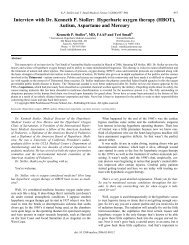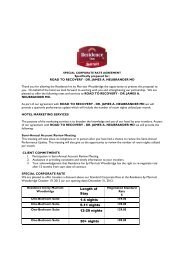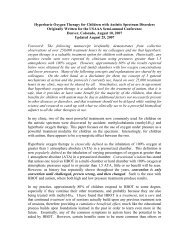Interview with Dr - Dr. Neubrander
Interview with Dr - Dr. Neubrander
Interview with Dr - Dr. Neubrander
You also want an ePaper? Increase the reach of your titles
YUMPU automatically turns print PDFs into web optimized ePapers that Google loves.
946<br />
D.A. Rossignol and T. Small/Medical Veritas 3 (2006) 944–951<br />
fusion in 81% of patients <strong>with</strong> Sjögren’s syndrome. In one<br />
SPECT study of patients <strong>with</strong> systemic lupus erythematosus,<br />
59% had evidence of cerebral hypoperfusion. Furthermore,<br />
treatment of the inflammation found in lupus <strong>with</strong> iloprost and<br />
methylprednisolone normalized cerebral blood flow on followup<br />
SPECT scans.<br />
How does this offer theoretical hope for children <strong>with</strong> autism<br />
It is conceivable that the cerebral hypoperfusion found in<br />
autistic children may be triggered by neuroinflammation and<br />
therefore may be reversible <strong>with</strong> anti-inflammatory modalities.<br />
In fact, some researchers and DAN physicians are seeing improvements<br />
in autism symptoms <strong>with</strong> anti-inflammatory agents<br />
including IV-IG and Actos.<br />
Which zones of the autistic brain are affected by decreased<br />
blood flow, and which symptoms correlate to each zone<br />
There have been dozens of studies showing relative decreased<br />
blood flow to the brain in autistic children. Decreased<br />
perfusion of the temporal lobes is a consistent finding in many<br />
studies of autistic children <strong>with</strong> one study demonstrating that<br />
76% of autistic children have decreased blood flow to the temporal<br />
areas when compared to typical children. Two larger controlled<br />
studies (21-23 autistic children) using SPECT and PET<br />
scans confirmed significant bitemporal hypoperfusion. In both<br />
of these studies, the control group was mentally retarded; therefore,<br />
the hypoperfusion could not be attributed to mental retardation<br />
alone. Another SPECT study of 31 autistic children, 16<br />
of whom had epilepsy, also demonstrated reduction of cerebral<br />
blood flow to the temporal lobes. Of note, cerebral blood flow<br />
was not different between those <strong>with</strong> and <strong>with</strong>out epilepsy, suggesting<br />
that epilepsy itself was not associated <strong>with</strong> hypoperfusion<br />
in these individuals. A more recent PET study of 11 autistic<br />
children revealed diminished blood flow to the left temporal<br />
area, including Wernicke’s area (which is involved in language<br />
comprehension) and Brodmann’s area 21 (involved in auditory<br />
processing and language), when compared to age-matched mentally<br />
retarded children.<br />
Interestingly, an association between temporal lobe abnormalities<br />
and the subsequent development of secondary autism<br />
has been described in tuberous sclerosis, infantile spasms, herpes<br />
simplex encephalitis, and an acute encephalopathic illness<br />
in children.<br />
I said earlier that this hypoperfusion correlates <strong>with</strong> many<br />
core autism symptoms. Decreased blood flow to the temporal<br />
lobes has also been correlated <strong>with</strong> an “Obsessive desire for<br />
sameness” and “impairments in communication and social interaction”<br />
and also <strong>with</strong> decreased IQ. Decreased blood flow to<br />
the temporal lobes and amygdala has been correlated <strong>with</strong> impairments<br />
in processing facial expressions and emotions and<br />
trouble recognizing familiar faces. Decreased blood flow to the<br />
thalamus has been correlated <strong>with</strong> repetitive, self-stimulatory,<br />
and unusual behaviors including resistance to changes in routine<br />
and environment.<br />
Does hypoperfusion worsen <strong>with</strong> age, and can this be prevented<br />
In one study, hypoperfusion of the prefrontal and left temporal<br />
areas worsened and became “quite profound” as the age of<br />
the autistic child increased. This diminished perfusion was correlated<br />
<strong>with</strong> decreased language development. The authors concluded<br />
that hypoperfusion “subsequently prevents development<br />
of true verbal fluency and development in the temporal and<br />
frontal areas associated <strong>with</strong> speech and communication.”<br />
What further research is needed <strong>with</strong> regard to hypoperfusion<br />
or neuroinflammation<br />
As we have discussed, hypoperfusion of the temporal and<br />
other brain regions has been correlated <strong>with</strong> many of the clinical<br />
findings associated <strong>with</strong> autism including self-stimulatory<br />
behaviors and impairments in communication, sensory perception,<br />
and social interaction. This diminished blood flow may be<br />
mediated by neuroinflammation. Further studies on the effects<br />
of inflammation on blood flow in the autistic brain are needed,<br />
especially studies involving the temporal lobes where hypoperfusion<br />
is common. We also need to study whether or not antiinflammatory<br />
treatments help reverse this hypoperfusion in<br />
autistic children.<br />
What is the problem <strong>with</strong> cerebral hypoperfusion How<br />
does oxygen delivered by HBOT reverse hypoxia in brain tissues<br />
caused by hypoperfusion<br />
Cerebral hypoperfusion causes hypoxia (or decreased oxygen),<br />
which triggers electrical failure in brain cells. Worsening<br />
hypoxia then eventually results in ion pump failure, which ultimately<br />
leads to cell death. Studies have shown that the oxygen<br />
delivered by HBOT can reverse hypoxia in brain tissues caused<br />
by hypoperfusion.<br />
How can hyperbaric oxygen therapy salvage some brain<br />
cells, and can it do this well after an insult involving hypoxia<br />
As I said, <strong>with</strong> hypoxia you first get cellular electrical failure<br />
and then ion pump failure which causes cell death. However,<br />
cells that have electrical failure but retain ion pump ability have<br />
been described as “idling” because they remain alive but nonfunctional.<br />
SPECT studies have confirmed the presence of these<br />
“idling cells,” which surround areas of focal ischemia (or decreased<br />
blood flow) and comprise what is termed the “ischemic<br />
penumbra.” Restoration of oxygenation, sometimes even years<br />
after the ischemic insult, can salvage these cells, which may<br />
explain why the acute findings of a stroke are poor predictors of<br />
ultimate clinical outcomes.<br />
Do we have SPECT scans that bear this out<br />
Neubauer has studied this phenomenon extensively. In one<br />
patient <strong>with</strong> an ischemic brain injury from a near drowning episode<br />
12 years earlier, he demonstrated that 80 sessions of<br />
HBOT at 1.5 ATA increased oxygenation to the ischemic penumbra<br />
on SPECT scans and significantly improved cognitive<br />
and motor function. Another study of three patients <strong>with</strong> brain<br />
injuries showed areas of what he called “dormant” neurons in<br />
the ischemic penumbra on SPECT scans prior to the comdoi:<br />
10.1588/medver.2006.03.00110





